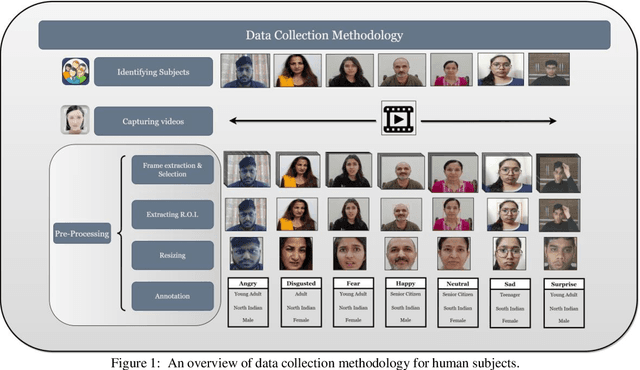Preyansh Agrawal
InFER: A Multi-Ethnic Indian Facial Expression Recognition Dataset
Sep 30, 2023



Abstract:The rapid advancement in deep learning over the past decade has transformed Facial Expression Recognition (FER) systems, as newer methods have been proposed that outperform the existing traditional handcrafted techniques. However, such a supervised learning approach requires a sufficiently large training dataset covering all the possible scenarios. And since most people exhibit facial expressions based upon their age group, gender, and ethnicity, a diverse facial expression dataset is needed. This becomes even more crucial while developing a FER system for the Indian subcontinent, which comprises of a diverse multi-ethnic population. In this work, we present InFER, a real-world multi-ethnic Indian Facial Expression Recognition dataset consisting of 10,200 images and 4,200 short videos of seven basic facial expressions. The dataset has posed expressions of 600 human subjects, and spontaneous/acted expressions of 6000 images crowd-sourced from the internet. To the best of our knowledge InFER is the first of its kind consisting of images from 600 subjects from very diverse ethnicity of the Indian Subcontinent. We also present the experimental results of baseline & deep FER methods on our dataset to substantiate its usability in real-world practical applications.
* In Proceedings of the 15th International Conference on Agents and Artificial Intelligence Volume 3: ICAART; ISBN 978-989-758-623-1; ISSN 2184-433X, SciTePress, pages 550-557. DOI: 10.5220/0011699400003393
NFResNet: Multi-scale and U-shaped Networks for Deblurring
Dec 12, 2022



Abstract:Multi-Scale and U-shaped Networks are widely used in various image restoration problems, including deblurring. Keeping in mind the wide range of applications, we present a comparison of these architectures and their effects on image deblurring. We also introduce a new block called as NFResblock. It consists of a Fast Fourier Transformation layer and a series of modified Non-Linear Activation Free Blocks. Based on these architectures and additions, we introduce NFResnet and NFResnet+, which are modified multi-scale and U-Net architectures, respectively. We also use three different loss functions to train these architectures: Charbonnier Loss, Edge Loss, and Frequency Reconstruction Loss. Extensive experiments on the Deep Video Deblurring dataset, along with ablation studies for each component, have been presented in this paper. The proposed architectures achieve a considerable increase in Peak Signal to Noise (PSNR) ratio and Structural Similarity Index (SSIM) value.
 Add to Chrome
Add to Chrome Add to Firefox
Add to Firefox Add to Edge
Add to Edge